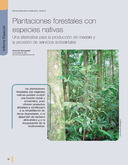| dc.contributor.author | Montagnini, F. | |
| dc.date.accessioned | 2015-03-19T22:00:50Z | |
| dc.date.available | 2015-03-19T22:00:50Z | |
| dc.date.issued | 2004-11 | |
| dc.identifier.issn | e-ISSN: 1659-1216 | es_EN |
| dc.identifier.uri | https://repositorio.catie.ac.cr/handle/11554/6673 | |
| dc.identifier.uri | 466779 | es_ES |
| dc.description.abstract | El mercado de la madera en América Central se ha
nutrido tradicionalmente de los bosques naturales.
Sin embargo, con el avance de la deforestación, el
establecimiento de plantaciones forestales es una
alternativa que varios países como Costa Rica han
estimulado en años recientes. Además de contribuir a suplir la creciente demanda de madera, las
plantaciones proveen servicios ambientales; por
ejemplo, el almacenaje de carbono. Pero además,
las plantaciones pueden contribuir a la recuperación de suelos y de la biodiversidad de tierras degradadas. En este trabajo se presentan experiencias con especies forestales nativas, en plantaciones puras y mixtas generadas en Costa Rica en los
últimos doce años. Se presentan resultados de
crecimiento en volumen, producción de biomasa y
recuperación de la fertilidad del suelos y de la biodiversidad en terrenos degradados. Se destacan
las especies más promisorias en cada caso y se
dan algunas recomendaciones para el uso de
plantaciones con estas especies. Se sugiere que
se establezcan incentivos para la reforestación y se
estimule el establecimiento y mantenimiento de
plantaciones con especies nativas siguiendo los
modelos que hasta el momento han tenido éxito. | es_ES |
| dc.description.abstract | In Central
America, the timber market has traditionally used
wood from natural forests. However, with the
advance of deforestation, the establishment of
forest plantations is an alternative that several
countries like Costa Rica have stimulated in recent
years. In addition to contributing to supply the
increasing demand for timber, plantations provide
environmental services; for example, carbon
sequestration and storage. Plantations can also
contribute to the recovery of soils and biodiversity
of degraded lands. In this article, results are shown
of experiments with native tree species growing in
pure and mixed plantations in Costa Rica over the
last twelve years. Results are shown on growth in
volume, biomass production and recovery of soil
fertility and biodiversity in degraded lands. The
most promising species are shown for each case,
and recommendations are given for the use of
plantations including these species. It is suggested
that incentives for reforestation should be used,
and that the establishment and maintenance of
plantations should be stimulated following the
successful models presented in this article. | |
| dc.format.extent | 8 páginas | spa_SPA |
| dc.format.mimetype | pdf | |
| dc.language.iso | es | es_ES |
| dc.publisher | CATIE, Turrialba (Costa Rica) | es_ES |
| dc.publisher | CATIE, Turrialba (Costa Rica) | |
| dc.relation.ispartof | Recursos Naturales y Ambiente Número 43 (Noviembre 2004), páginas 28-35 | |
| dc.rights.uri | https://creativecommons.org/licenses/by-nc-nd/4.0/ | |
| dc.subject | TERMINALIA | es_ES |
| dc.subject | DIPTERYX | es_ES |
| dc.subject | CALOPHYLLUM | es_ES |
| dc.subject | SWIETENIA MACROPHYLLA CEDRELA | es_ES |
| dc.subject | ODORATA | es_ES |
| dc.subject | CORDIA ALLIODORA | es_ES |
| dc.subject | ORGANISMOS INDIGENOS | es_ES |
| dc.subject | PLANTACION FORESTAL | es_ES |
| dc.subject | VOLUMEN | es_ES |
| dc.subject | TABLAS DE CUBICACION | es_ES |
| dc.subject | BIOMASA | es_ES |
| dc.subject | SERVICIOS | es_ES |
| dc.subject | COSTA RICA | es_ES |
| dc.title | Plantaciones forestales con especies nativas: una alternativa para la producción de madera y provisión de servicios ambientales | es_ES |
| dc.title.alternative | Forest plantations with native species; an
alternative for wood production and the
provision of environmental services. | |
| dc.type | Artículo | es_ES |
| dc.journal.issueNumber | 43 | |
| dc.journal.pages | 28-35 | |



